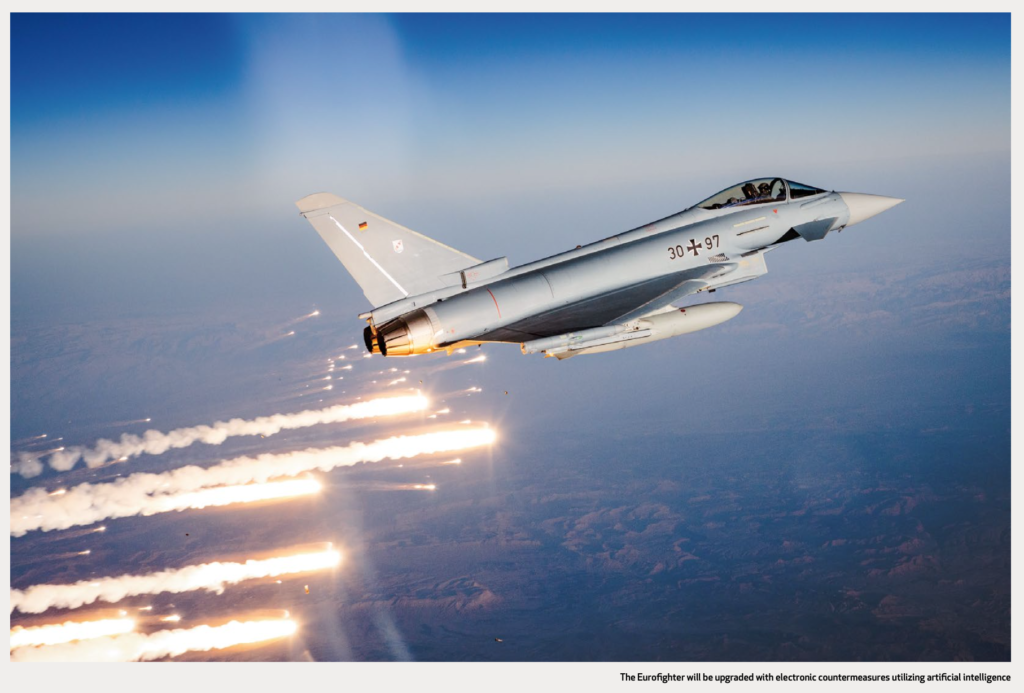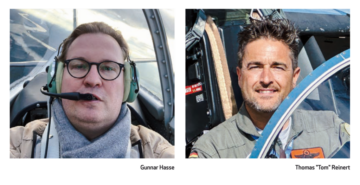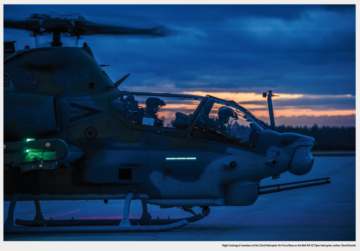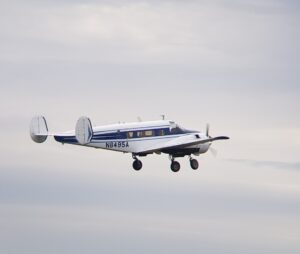The landscape of global air defense is rapidly transforming, and at the forefront of this evolution is Lieutenant General Ingo Gerhartz. This exclusive interview for ACE Magazine delves deep into the realms of NATO’s military prowess, the advancements of the German Air Force, and the revolutionary changes brought by emerging aerospace technologies. Through insightful queries, we uncover General Gerhartz’s perspective on NATO’s most significant deployment exercise to date, the readiness to face modern threats, and the integration of cutting-edge technologies like AI and hypersonics. This conversation offers a comprehensive look at the intricate mechanisms of global security and the relentless pursuit of peace in a world facing new challenges.
Lieutenant General Gerhartz, last year you managed to summon 25 air forces in Germany and conducted the greatest deployment exercise since the foundation of NATO. What are your views in hindsight?
During my initial meeting with the US Air National Guard, I put forward the proposal for a large-scale deployment exercise of US Air Assets in Europe. Lieutenant General Michael Loh, the Director of the Air National Guard, emerged as a fervent supporter and key ally in this endeavor. Under the leadership of the German Air Force, we successfully assembled 250 aircraft and executed highly sophisticated air operations across Germany and the airspace of adjacent NATO nations on a daily basis. Additionally, we undertook reassurance missions to NATO’s eastern and southeastern partners. I extend my gratitude to the Czech Air Force for its significant contributions, particularly in offering airspace for UAS operations and deploying Gripen aircraft. Collectively, we delivered a potent message of credible deterrence and showcased the strength of transatlantic partnerships. This exercise conveyed a powerful assurance to the people of Germany and our allies about their reliance on the defensive and operational capabilities of our air forces. We unequivocally demonstrated to all: Airpower is the First Responder!
In view of the Russian threat to security in Europe, to what extent is the German Air Force able to defend Germany and its citizen?
Firstly, it’s crucial to clarify that the question isn’t about Germany’s solitary defense capabilities but rather about its ability to defend the NATO Alliance collectively. Following the Russian invasion of Ukraine, the German Chancellor announced a special 100 billion Euro fund for the military, signaling a significant stride towards modernizing our forces, particularly in the air domain. We’ve made substantial advancements, including the order of 35 F-35 stealth aircraft, complete with weapons and maintenance, with an anticipation of the first eight aircraft arriving in 2026 for pilot training. Joining the F-35 user nations is a strategic move for Germany, opening avenues for extensive cooperation, notably with partners like the Czech Republic.
Additionally, 15 Eurofighters are slated for upgrades to enhance electronic combat capabilities, effectively replacing the outdated TORNADO ECR fleet. We’re also set to bolster our heavy lift capacity with 60 CH-47 Chinook helicopters by 2027, positioning the German Air Force as the second-largest CH-47 fleet operator within NATO. The impending missile threats have catalyzed the acquisition of our first ARROW anti-missile defense system, expected to be operational by 2025. The Arrow 3 missile, designed to intercept intermediate-range missiles before they re-enter the atmosphere, alongside 6 IRIS T SLM systems, will significantly enhance our air defense against cruise missiles and drones.

Our European Sky Shield Initiative promotes cost-efficient defense solutions through the communal procurement of combat-proven systems, extending over a 40 km range. The Baltic Sea air defense site in Todendorf is pivotal, offering extensive training and educational opportunities for ESSI partner nations. While the 100 billion Euro funding is substantial, it underscores the importance of continuous investment in our armed forces. Ensuring the readiness and operational capability of NATO’s air power is essential for our collective defense and security, today and into the future.
What new aerospace technologies do you think will have impact on modern national and alliance defense?
Currently, several emerging technologies are poised to significantly alter the application of air and space power. In my view, drones, space utilization, hypersonics, and artificial intelligence represent the most pivotal advancements. Drone technology has already become a staple on the modern battlefield, enabling reconnaissance, target monitoring, and strikes without endangering human lives. The critical aspect of drone warfare is the potential for a single drone to penetrate defenses and destroy its target, emphasizing the need for robust countermeasures.
Space has become crucial for Europe’s safety and security, with satellites playing a vital role in ensuring reliable, secure long-distance communications. These satellites, equipped with infrared sensors, are instrumental in detecting ballistic missile launches, providing early warnings, and enabling effective defense against sudden threats.

Hypersonic technology offers the ability to strike targets more swiftly, significantly reducing response times. Aircraft and missiles capable of reaching hypersonic speeds enhance defense capabilities by enabling rapid reactions to emerging threats.
Artificial intelligence is set to revolutionize the battlefield, offering transformative potential in data analysis. AI technologies enable NATO forces to sift through vast amounts of information to detect patterns, forecast threats, and refine decision-making processes. This technological evolution underscores the importance of adapting and integrating new capabilities to maintain strategic advantages in future conflicts.
To what extent will drone technology have an impact on the future of air warfare?
Drones have demonstrated their capability to overwhelm complex air defenses, as observed in recent conflicts such as the Russian invasion of Ukraine and the conflict between Azerbaijan and Armenia. These conflicts highlighted the extensive use of drones against ground forces, where deploying them in large numbers posed significant challenges to defensive measures. Given these developments, it is my belief that drones must be integrated as a core component of modern air forces, particularly for engaging and neutralizing enemy air defense systems.

This is the rationale behind the inclusion of unmanned aircraft systems in our Future Combat Air System (FCAS). Remote Carriers (RC), a key element of FCAS, are designed to pinpoint the locations of enemy forces and penetrate their advanced air defense networks. To counter the threat posed by large drone formations, a multi-layered approach to air defense is essential. This involves the deployment of various air defense systems, ranging from short to very short range, and will eventually include the adoption of laser-based systems. This year marks the introduction of the IRIS-T SLM system into our arsenal, signifying a significant step forward in enhancing our defensive capabilities against the evolving drone threat.
The Luftwaffe is operating the Bundeswehr Space Command? How vital is that for our security?
The establishment of the Bundeswehr Space Command has markedly enhanced Germany’s capabilities in space, centralizing all military space activities, including the protection and defense of space systems. Operating around the clock, the Space Command ensures continuous space situational awareness and provides operational support from space. It oversees space operations and the tactical deployment of our space assets.

Collaboration with the German Aerospace Centre and the Fraunhofer Institute has been instrumental, leveraging Europe’s most advanced tracking and radar imaging systems to generate an accurate depiction of space activities. The addition of increasingly sophisticated sensors, and the prospective integration of a space-based missile launch warning system, underscores our commitment to significantly bolstering Europe’s defense mechanisms in space. This strategic enhancement not only strengthens our national defense posture but also contributes substantially to the collective security and operational capabilities within the European theater.
You have mentioned that AI is a game changer for air power. Why?
Artificial Intelligence (AI) is set to significantly enhance the efficiency of NATO’s air power deployment. By integrating AI into our defense networks, we can improve decision-making processes, automate mundane tasks, and sift through massive datasets for actionable intelligence. To illustrate this, let me share two examples from the Luftwaffe:
Firstly, 15 Eurofighters in our current fleet are being outfitted with Europe’s most sophisticated electronic combat system, which employs AI to support informed decision-making. Additionally, during the Exercise Kalkar Sky, AI was instrumental in managing approximately 300 sorties flown by military aircraft. Operational planners, who typically spend hours analyzing and processing the immense volume of information required for air operation setup, will find AI to be a game-changer. AI has the capability to compile and scrutinize data from various sources, including airborne sensors, satellites, drones, and others, to furnish a comprehensive and instantaneous overview of both friendly and adversarial air forces.
This augmented situational awareness empowers commanders to make well-informed decisions regarding the application of air power. I was particularly astounded by the AI’s ability to generate suggestions on the most effective and successful use of air assets in specific scenarios within seconds. This experience convinced me of AI’s transformative potential in defense capabilities. It’s clear that AI will aid commanders in their decision-making processes, yet it’s important to note that it will not replace them. AI serves as a powerful tool that enhances human judgment, ensuring that strategic decisions remain under human oversight.
Hypersonic missiles travel at speeds faster than Mach 5. How can we defend against them?
The robustness of NATO’s air defense against hypersonic threats is crucial. Hypersonic platforms, with their rapid response, long-range capabilities, and improved survivability, are developed to enhance defense and deter threats. Recent conflicts have shown that hypersonic missiles, such as the Kinzhal used by Russian forces, significantly shorten early warning times, posing a challenge on the battlefield.
The question arises: Are we defenseless against such advancements? My answer focuses on the importance of training and tactics. Evidence from the conflict in Ukraine demonstrates that our donated PATRIOT Systems have successfully countered Kinzhal missiles. This success is largely attributed to the intensive training of Ukrainian air defense personnel in Germany. However, it’s clear that our defense systems must continuously evolve, through updates and modernization, to address future threats effectively.
What impact do these technologies have on cooperation and interoperability with other air forces and defense establishments in international alliances?
Over the past five years, the Luftwaffe has engaged in extensive exercises worldwide. Within 24 hours, we deployed Eurofighters to the Indo-Pacific region, collaborated with the Japanese Defence Forces, and participated in Pitch Black in Australia. Our regular training sessions with the Israeli Air Force highlight our commitment to international cooperation. We’ve also embraced the “plug & fight” concept for the Eurofighter, facilitating cross-maintenance during air policing missions along NATO’s eastern flank. Such regular training and the adoption of compatible technologies enhance interoperability among partner nations, enabling more effective collaboration and capability integration.
However, the future complexity of air operations demands proficiency in managing vast amounts of data. In my view, the mastery of artificial intelligence (AI) will be pivotal in dominating the battlespace. Germany, France, and Spain’s joint development of the Future Combat Air System (FCAS) over the coming decades underscores this. The successful integration of an AI backbone into FCAS will be crucial for achieving air superiority, particularly in terms of the speed, precision, and effectiveness of combined air operations. AI’s role will be indispensable in future conflicts, especially against peer competitors, emphasizing the strategic importance of technological advancement in modern warfare.
How will the Air Force ensure it has sufficient qualified personnel to effectively use and maintain these new technologies?
To make it clear: The best technology cannot replace people. It’s absolutely vital for us to invest in extensive training programs to ensure our personnel are up-to-date with the latest technology. This includes both theoretical training and practical exercises to cultivate the required skills. Currently, we’re modernizing our entire aircraft simulator inventory, aiming to create a fully network-enabled simulator architecture for our tactical air wings. The Luftwaffe is committed to providing our servicemen and women with clear career paths, including opportunities to specialize in specific technologies and become field experts.
In the realm of space operations, we’ve established a career path specifically for personnel in our space branch. We’re on the lookout for qualified specialists who possess the necessary technical know-how. Therefore, I’m in close contact with our universities to identify and foster talent. To sum it up: The adaptation to the changing needs of technology development is crucial for maintaining future safety and security. Our focus on advanced training and specialization ensures we stay prepared for the challenges ahead.
Concluding our insightful session with Lieutenant General Ingo Gerhartz, we gain a profound understanding of the complexities and necessities of modern air defense. This interview highlights the convergence of airpower, technology, and expertise in shaping the future of national and international defense. As we peer into the future, the insights provided here underscore the importance of continuous innovation, strategic collaboration, and the ability to adapt in an increasingly interconnected and complex global landscape.
Interviewed and edited by: Katerina Urbanova
Photo Credit: Luftwaffe
- SEO Powered Content & PR Distribution. Get Amplified Today.
- PlatoData.Network Vertical Generative Ai. Empower Yourself. Access Here.
- PlatoAiStream. Web3 Intelligence. Knowledge Amplified. Access Here.
- PlatoESG. Carbon, CleanTech, Energy, Environment, Solar, Waste Management. Access Here.
- PlatoHealth. Biotech and Clinical Trials Intelligence. Access Here.
- Source: https://aero-space.eu/2024/04/16/ingo-gerhartz-masterminding-air-power-in-the-21st-century/
- :has
- :is
- :not
- :where
- $UP
- 09
- 100
- 15%
- 2025
- 2026
- 21st
- 24
- 25
- 250
- 26
- 300
- 35%
- 40
- 49
- 5
- 500
- 6
- 60
- a
- ability
- Able
- About
- absolutely
- accurate
- ace
- achieving
- acquisition
- across
- actionable
- activities
- adapt
- adaptation
- adapting
- addition
- Additionally
- address
- adjacent
- Adoption
- advanced
- advancement
- advancements
- advantages
- adversarial
- Aerospace
- against
- ahead
- AI
- Aid
- Aiming
- AIR
- Air Force
- aircraft
- airspace
- All
- Alliance
- Alliances
- Ally
- along
- alongside
- already
- also
- alter
- among
- amounts
- an
- analysis
- analyzing
- and
- announced
- answer
- anticipation
- Application
- approach
- approximately
- architecture
- ARE
- arises
- armed
- around
- arriving
- Arsenal
- artificial
- artificial intelligence
- Artificial intelligence (AI)
- AS
- aspect
- assembled
- Assets
- assurance
- astounded
- At
- Atmosphere
- augmented
- Australia
- automate
- avenues
- awareness
- Backbone
- basis
- Battlefield
- BE
- become
- been
- before
- behind
- being
- belief
- BEST
- between
- Billion
- Black
- bolster
- bolstering
- both
- Branch
- brought
- but
- by
- CAN
- cannot
- capabilities
- capability
- capable
- Capacity
- Career
- carriers
- central
- central europe
- centralizing
- centre
- Century
- challenge
- challenges
- Changer
- Changes
- changing
- citizen
- clear
- Clock
- Close
- collaborated
- collaboration
- Collective
- collectively
- combat
- combined
- coming
- command
- commitment
- committed
- communal
- Communications
- compatible
- competitors
- complete
- complex
- complexities
- complexity
- component
- comprehensive
- concept
- conducted
- conflict
- conflicts
- contact
- continuous
- continuously
- contributes
- contributions
- Convergence
- Conversation
- conveyed
- convinced
- cooperation
- Core
- Counter
- create
- credible
- credit
- critical
- critical aspect
- crucial
- cruise
- Cultivate
- Current
- Currently
- cutting-edge
- Cutting-Edge Technologies
- Czech
- czech republic
- daily
- data
- data analysis
- datasets
- Date
- decades
- Decision Making
- decisions
- deep
- defence
- defend
- Defense
- defenses
- defensive
- delivered
- delves
- demands
- demonstrated
- demonstrates
- deployed
- deploying
- deployment
- designed
- destroy
- detect
- detecting
- developed
- Development
- developments
- Director
- do
- domain
- dominating
- donated
- drone
- drone technology
- Drones
- during
- Early
- eastern
- edited
- educational
- Effective
- effectively
- effectiveness
- efficiency
- eight
- Electronic
- element
- embraced
- emerged
- emerging
- emerging technologies
- emphasizing
- employs
- empowers
- enable
- enabling
- endangering
- endeavor
- engaged
- engaging
- enhance
- enhanced
- enhancement
- Enhances
- enhancing
- ensure
- ensures
- ensuring
- Entire
- equipped
- especially
- essential
- established
- establishment
- Ether (ETH)
- Euro
- Europe
- European
- Europes
- eventually
- evidence
- evolution
- evolve
- evolving
- examples
- Exclusive
- executed
- Exercise
- exercises
- expected
- experience
- expertise
- experts
- extend
- extending
- extensive
- extent
- Face
- facilitating
- facing
- faster
- field
- Find
- First
- five
- FLEET
- Focus
- focuses
- following
- For
- Force
- Forces
- Forecast
- forefront
- Forward
- Foster
- Foundation
- France
- friendly
- from
- fully
- fund
- funding
- future
- Gain
- game
- game-changer
- General
- generate
- German
- Germany
- given
- Global
- gratitude
- greatest
- Ground
- Guard
- Have
- heavy
- helicopters
- here
- High
- Highlight
- Highlighted
- highlights
- highly
- hindsight
- HOURS
- How
- However
- HTTPS
- human
- i
- identify
- illustrate
- Imaging
- immense
- Impact
- impending
- importance
- important
- improve
- improved
- in
- include
- includes
- Including
- inclusion
- increasingly
- indispensable
- information
- informed
- initial
- Initiative
- Innovation
- insightful
- insights
- Institute
- instrumental
- integrated
- Integrating
- integration
- Intelligence
- intensive
- interconnected
- International
- Interoperability
- Interview
- into
- intricate
- Introduction
- invasion
- inventory
- Invest
- investment
- involves
- iris
- Israeli
- IT
- ITS
- Japanese
- joining
- joint
- Key
- landscape
- large
- large-scale
- largely
- Last
- Last Year
- latest
- launch
- launches
- Leadership
- let
- leveraging
- like
- Lives
- locations
- Look
- made
- magazine
- maintain
- maintaining
- maintenance
- make
- managed
- managing
- massive
- max-width
- me
- measures
- mechanisms
- meeting
- mentioned
- message
- Michael
- Military
- missiles
- missions
- Modern
- Modern Warfare
- modernization
- modernizing
- monitoring
- more
- most
- move
- multi-layered
- must
- my
- National
- Nations
- necessary
- necessities
- Need
- needs
- networks
- New
- New technologies
- notably
- note
- numbers
- observed
- of
- offering
- Offers
- on
- only
- opening
- operating
- operation
- operational
- Operations
- operator
- opportunities
- order
- Other
- Others
- our
- outdated
- over
- Oversight
- overview
- participated
- particularly
- partner
- partners
- partnerships
- past
- path
- paths
- patterns
- peace
- peer
- People
- Personnel
- perspective
- pilot
- Pitch
- pivotal
- Platforms
- plato
- Plato Data Intelligence
- PlatoData
- playing
- poised
- policing
- posed
- posing
- positioning
- possess
- potent
- potential
- power
- powerful
- Practical
- Precision
- prepared
- processes
- processing
- procurement
- profound
- Programs
- promotes
- proposal
- prospective
- protection
- provided
- provides
- providing
- prowess
- pursuit
- put
- qualified
- queries
- question
- radar
- range
- ranging
- rapid
- rapidly
- rather
- rationale
- reaching
- reactions
- Readiness
- realm
- realms
- reassurance
- recent
- reducing
- refine
- regarding
- region
- regular
- relentless
- reliable
- reliance
- remain
- remote
- replace
- represent
- Republic
- required
- response
- response times
- revolutionary
- revolutionize
- robust
- robustness
- Role
- russian
- Safety
- Safety and Security
- satellites
- scenarios
- SEA
- second-largest
- seconds
- secure
- security
- sensors
- serves
- session
- sessions
- set
- setup
- several
- shaping
- Share
- Shield
- Short
- showcased
- shown
- Sift
- significant
- significantly
- signifying
- simulator
- since
- single
- site
- skills
- sky
- Solutions
- sophisticated
- Sources
- Space
- space-based
- special
- specialists
- specialize
- specific
- specifically
- speed
- speeds
- spend
- stay
- Stealth
- Step
- Strategic
- strength
- Strengthens
- stride
- strike
- Strikes
- substantial
- substantially
- success
- successful
- Successfully
- such
- sudden
- sufficient
- sum
- superiority
- support
- supporter
- swiftly
- system
- Systems
- T
- tactical
- tactics
- Talent
- Target
- targets
- tasks
- Technical
- technological
- Technologies
- Technology
- Technology Development
- terms
- than
- that
- The
- The Future
- Theater
- their
- Them
- theoretical
- therefore
- These
- they
- Think
- this
- this year
- threat
- threats
- Through
- times
- to
- today
- tool
- tornado
- towards
- Tracking
- Training
- Transatlantic
- transformative
- transforming
- travel
- two
- typically
- Ukraine
- Ukrainian
- uncover
- under
- underscore
- underscores
- understanding
- undertook
- Universities
- up-to-date
- Updates
- upgrades
- us
- use
- used
- User
- utilization
- various
- Vast
- very
- View
- views
- vital
- volume
- warning
- was
- we
- Weapons
- What
- which
- while
- WHO
- why
- will
- wings
- with
- within
- without
- Women
- world
- worldwide
- year
- years
- yet
- you
- Your
- zephyrnet










